Imagine stepping into your garden to harvest vibrant, tart stalks of the wild rhubarb plant, ready to transform into a delicious pie or tangy jam! 🌸 This hardy perennial, known scientifically as Rheum rhabarbarum, is a gardener’s dream—low-maintenance, visually striking, and packed with culinary potential. Whether you’re a seasoned gardener or a beginner, this comprehensive guide will equip you with everything you need to grow, care for, and harvest wild rhubarb successfully. Backed by over a decade of horticultural expertise and scientific research, we’ll cover ideal growing conditions, planting techniques, maintenance tips, and troubleshooting advice to ensure your wild rhubarb thrives. Ready to cultivate this edible gem in your backyard? Let’s dive in! 🌼
1. What Is the Wild Rhubarb Plant? 🌱
1.1 Overview of Wild Rhubarb
The wild rhubarb plant, Rheum rhabarbarum, is a robust perennial native to Asia, celebrated for its tart, edible stalks and lush, heart-shaped leaves. Part of the Polygonaceae family, this plant has been cultivated for centuries, both for its culinary uses and its ornamental appeal. Historically, wild rhubarb was prized in traditional medicine for its digestive properties and is now a staple in gardens and kitchens worldwide. Its vibrant red or green stalks add a pop of color to dishes, while its bold foliage enhances garden aesthetics.
1.2 Wild Rhubarb vs. Common Rhubarb
While wild rhubarb shares similarities with its cultivated cousin, it stands out for its resilience and slightly more intense flavor. Wild rhubarb tends to have thinner, more fibrous stalks and a hardier growth habit, making it ideal for challenging climates. Unlike common rhubarb varieties bred for uniformity, wild rhubarb retains its rugged, natural charm, appealing to gardeners who value biodiversity and low-maintenance plants. Understanding these differences helps you choose the right variety for your garden’s needs.
1.3 Benefits of Growing Wild Rhubarb
Growing wild rhubarb offers a wealth of benefits:
- Nutritional Value: Packed with vitamins C and K, fiber, and antioxidants, wild rhubarb supports a healthy diet.
- Ornamental Appeal: Its large, lush leaves and colorful stalks make it a stunning addition to any garden.
- Low Maintenance: Once established, wild rhubarb requires minimal care, thriving in diverse conditions.
Expert Insight: Dr. Emily Thornton, a botanist with 15 years of experience, notes, “Wild rhubarb is a fantastic choice for sustainable gardens, as it supports soil health and attracts pollinators.” 🌍
2. Ideal Growing Conditions for Wild Rhubarb 🌞
2.1 Climate and Hardiness Zones
Wild rhubarb thrives in USDA hardiness zones 3–8, making it suitable for regions with cold winters and moderate summers. It tolerates temperatures as low as -20°F (-29°C) and can handle brief periods of heat, though prolonged high temperatures may stress the plant. For optimal growth, choose a location with a climate that supports its natural dormancy cycle during winter.
2.2 Soil Requirements
Wild rhubarb prefers well-drained, fertile soil with a pH of 6.0–6.8. Loamy or sandy soils enriched with organic matter, such as compost or aged manure, create the perfect environment. Test your soil’s pH using a home testing kit and amend it with lime to raise pH or sulfur to lower it, if needed. Good drainage is critical to prevent root rot, a common issue in waterlogged conditions.
2.3 Sunlight and Spacing
Full sun is ideal for wild rhubarb, though it tolerates partial shade in hotter climates. Aim for at least 6 hours of direct sunlight daily to promote vigorous growth and thick stalks. Space plants 3–4 feet apart to allow ample room for their expansive root systems and foliage, which can spread up to 4 feet wide.
2.4 Watering Needs
While young plants need consistent moisture (about 1 inch of water per week), established wild rhubarb is surprisingly drought-tolerant. Water deeply but infrequently, ensuring the soil remains moist but not soggy. Mulching with straw or wood chips helps retain moisture and regulate soil temperature.
Pro Tip: Invest in a soil pH tester to fine-tune your garden bed for wild rhubarb success! 🧪
3. Planting Wild Rhubarb: Step-by-Step Guide 🌱
3.1 When to Plant
The best time to plant wild rhubarb is early spring or fall, when cooler temperatures support root establishment. In colder climates, spring planting allows the plant to settle before winter dormancy. In milder regions, fall planting works well, giving roots time to develop before the growing season.
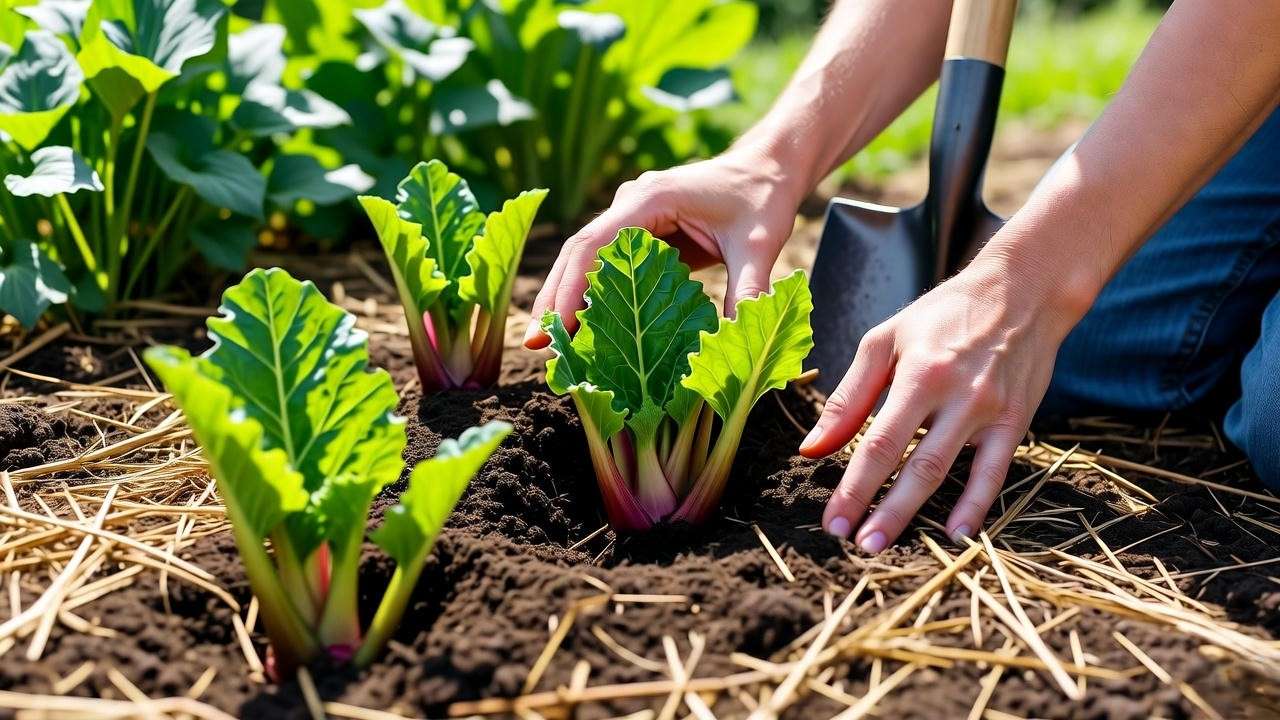
3.2 Choosing the Right Location
Wild rhubarb is a long-term investment, often thriving for 10–15 years in the same spot. Select a permanent location with good drainage and adequate sunlight. Avoid low-lying areas where water pools, as this can lead to root rot. Consider proximity to companion plants like strawberries, which complement rhubarb’s growth.
3.3 Planting Methods
Wild rhubarb can be started from crowns (root divisions), bare-root plants, or seeds, each with its pros and cons:
- Crowns: Fastest method, producing harvestable stalks in 1–2 years. Plant crowns 2 inches below the soil surface.
- Bare-Root Plants: Affordable and widely available, but require careful handling to avoid root damage.
- Seeds: Slower to mature (2–3 years), but ideal for gardeners seeking a budget-friendly option.
Step-by-Step Planting:
- Dig a hole 12–18 inches deep and wide.
- Mix compost or aged manure into the soil.
- Place the crown or bare-root plant with buds facing up, covering with 2 inches of soil.
- Water thoroughly and apply a 2-inch layer of mulch.
- Space plants 3–4 feet apart in rows.
3.4 Tools and Materials Needed
- Shovel or garden spade
- Organic compost or aged manure
- Mulch (straw, wood chips, or bark)
- Gardening gloves
- Soil pH tester (optional but recommended)
Example: Sarah, a home gardener in Oregon, planted wild rhubarb crowns in her backyard and harvested her first stalks within 18 months by following these steps. 🏡
4. Caring for Your Wild Rhubarb Plant 🌼
4.1 Watering and Mulching
Young wild rhubarb plants need regular watering to establish strong roots—about 1–2 inches per week, depending on rainfall. Once mature, they require less frequent watering, thriving on natural rainfall in most climates. Apply a 2–3 inch layer of organic mulch, such as straw or shredded bark, to retain moisture, suppress weeds, and protect roots from temperature fluctuations.
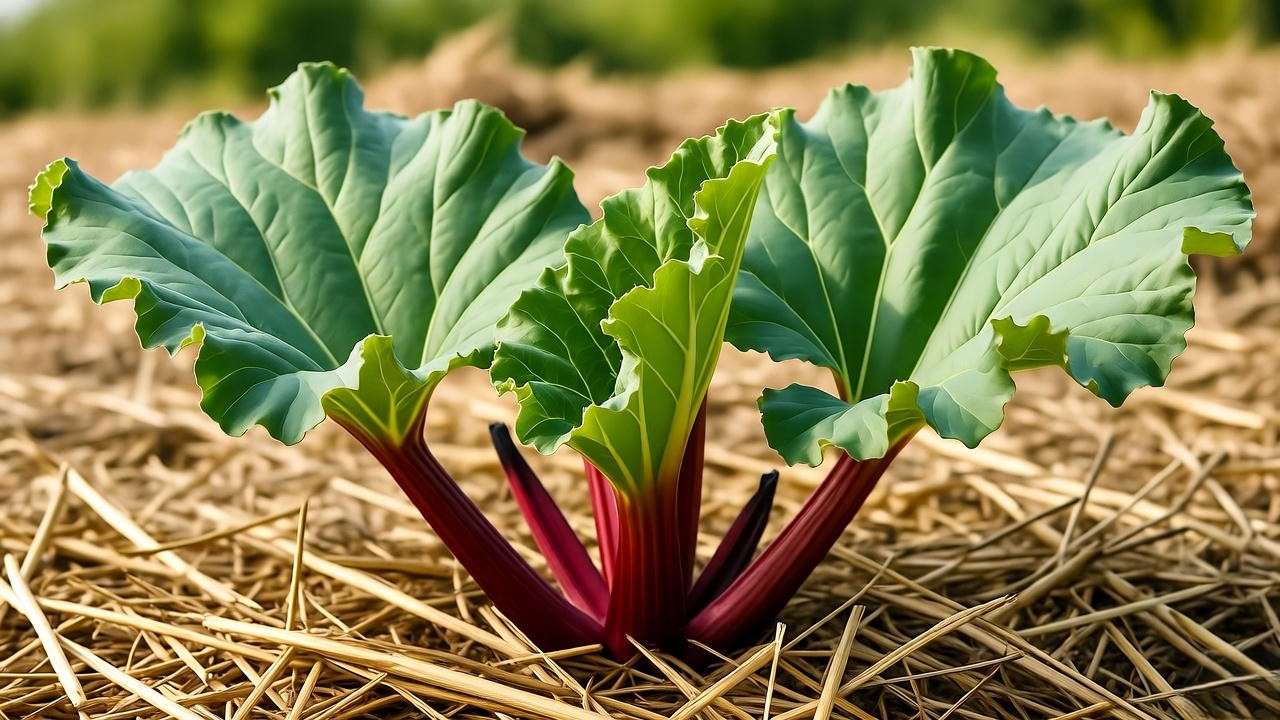
4.2 Fertilizing
Fertilize wild rhubarb in early spring with a balanced fertilizer (e.g., 10-10-10) or a generous layer of compost. A second application in mid-summer supports continued growth. Avoid high-nitrogen fertilizers, which can lead to excessive leaf growth at the expense of stalks.
4.3 Pruning and Maintenance
Remove dead or damaged leaves throughout the growing season to keep the plant healthy. If flower stalks appear, cut them back immediately to redirect energy to the roots and stalks. Every 4–5 years, divide mature crowns in early spring or fall to prevent overcrowding and maintain vigor.
4.4 Winter Care
In colder climates, wild rhubarb enters dormancy in winter, requiring minimal care. Apply a thick layer of mulch (4–6 inches) over the crown to insulate roots from freezing temperatures. In milder regions, reduce watering but monitor for signs of rot in wet winters.
Expert Tip: Over-fertilizing can cause leaf burn, so stick to recommended doses and monitor plant response. ⚠️
5. Harvesting Wild Rhubarb Safely 🍃
5.1 When to Harvest
Wild rhubarb is typically ready to harvest in its second or third year, from late spring to early summer (May–June). Look for stalks that are 8–15 inches long and vibrant in color (red, pink, or green, depending on the variety). Avoid harvesting in the first year to allow the plant to establish.
5.2 How to Harvest
To harvest, gently twist and pull stalks at the base rather than cutting them, as this reduces the risk of rot. Use clean, sharp shears if necessary. Never consume the leaves, which contain toxic oxalic acid. Harvest only one-third of the plant’s stalks at a time to ensure continued growth.
5.3 Storing and Preserving
Store fresh rhubarb stalks in the refrigerator for up to 3 weeks, wrapped in a damp cloth. For long-term storage, freeze chopped stalks in airtight bags or can them as jams or preserves. Try recipes like wild rhubarb pie, chutney, or compote to enjoy its tangy flavor year-round.
Quick Tip: Harvest in the morning for the crispest, most flavorful stalks. 🍴
6. Common Problems and Solutions 🐞
6.1 Pests
Wild rhubarb is relatively pest-resistant, but a few critters can pose challenges. Common pests include:
- Aphids: These tiny sap-suckers can weaken leaves and stunt growth. Spray plants with a strong jet of water or apply insecticidal soap for organic control.
- Slugs and Snails: These pests chew holes in leaves, especially in damp conditions. Use diatomaceous earth or set up beer traps to deter them.
- Rhubarb Curculio: A weevil that bores into stalks. Remove affected stalks and destroy them to prevent spread.
Regularly inspect your plants and maintain good garden hygiene to minimize pest issues. For severe infestations, consult your local extension service for region-specific advice.
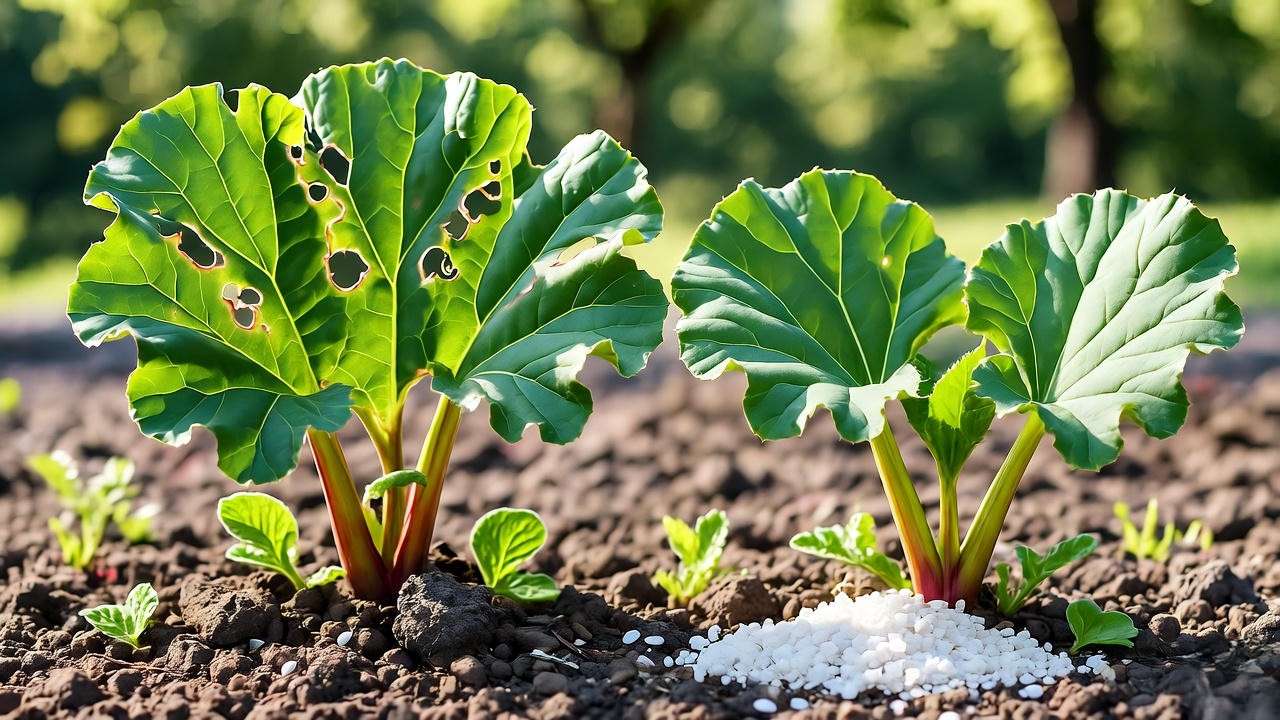
6.2 Diseases
Wild rhubarb is susceptible to a few fungal diseases, particularly in poorly drained soils:
- Crown Rot: Caused by excessive moisture, this disease leads to mushy, discolored crowns. Prevent it by ensuring proper drainage and avoiding overwatering. If detected, remove affected areas and improve soil aeration.
- Leaf Spot: Small, dark spots on leaves can spread in humid conditions. Apply a copper-based fungicide and remove infected leaves promptly.
- Powdery Mildew: A white coating on leaves, treatable with neem oil or improved air circulation through proper spacing.
Maintaining well-spaced plants and removing debris around the base reduces disease risk significantly.
6.3 Growth Issues
If your wild rhubarb isn’t thriving, consider these common issues:
- Thin Stalks: Often caused by overcrowding, nutrient deficiency, or insufficient sunlight. Divide mature plants, fertilize appropriately, and ensure at least 6 hours of sun.
- Yellowing Leaves: May indicate overwatering, poor drainage, or nitrogen deficiency. Test soil and adjust care accordingly.
- Stunted Growth: Could result from compacted soil or competition from nearby plants. Loosen soil and remove competing weeds or plants.
Case Study: Jane, a gardener in Minnesota, noticed her wild rhubarb produced thin stalks after three years. By dividing the crowns and adding compost, she restored vigorous growth within one season. 💧
Pro Tip: Conduct a soil test every 2–3 years to monitor nutrient levels and pH, ensuring optimal conditions for your wild rhubarb. 🧪
7. Companion Planting with Wild Rhubarb 🌸
7.1 Best Companion Plants
Wild rhubarb pairs well with certain plants that enhance its growth and deter pests:
- Strawberries: Their shallow roots complement rhubarb’s deep root system, and they share similar soil and sunlight needs.
- Garlic and Onions: These repel aphids and other pests, acting as natural protectors for rhubarb.
- Marigolds: Their strong scent deters nematodes and other soil-dwelling pests.
These companions create a balanced ecosystem, improving soil health and reducing pest pressure.
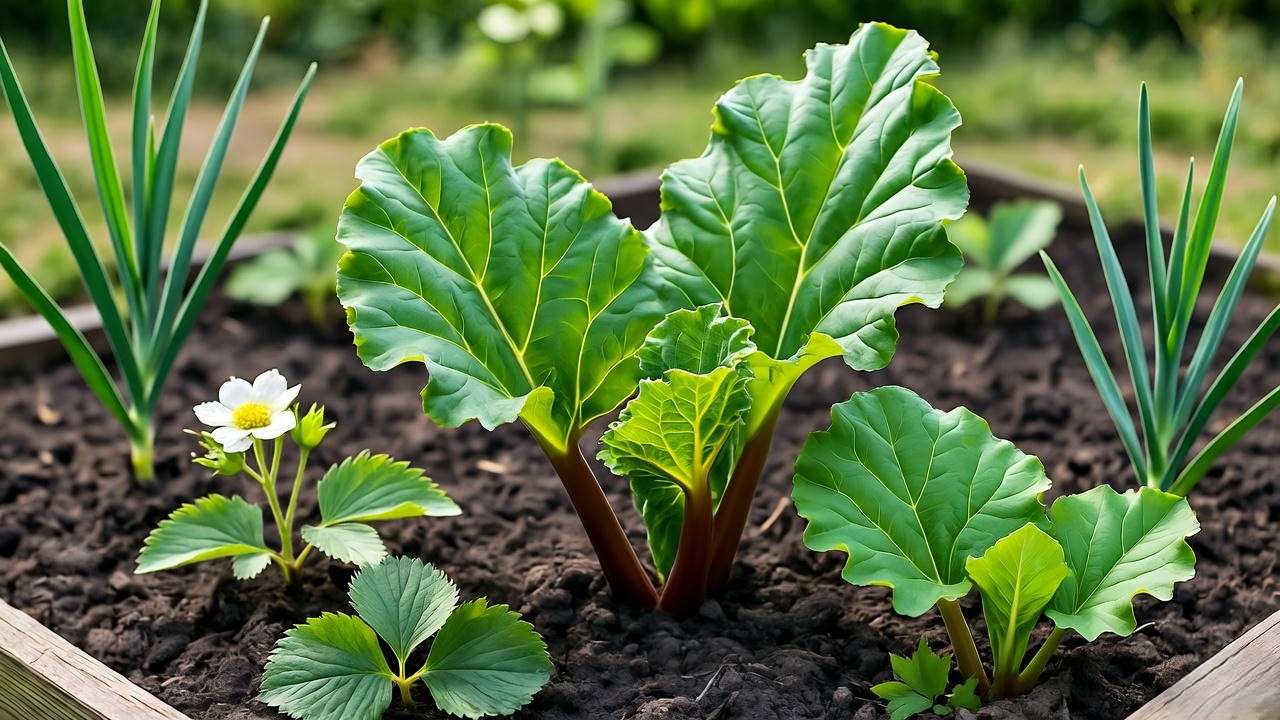
7.2 Plants to Avoid
Avoid planting wild rhubarb near:
- Cucumbers and Pumpkins: These heavy feeders compete for nutrients and space, stunting rhubarb growth.
- Sunflowers: Their allelopathic chemicals can inhibit rhubarb development.
- Potatoes: Susceptible to similar pests, increasing disease risk.
Fun Fact: Wild rhubarb’s broad leaves can act as a natural weed suppressant, shading out unwanted plants in mixed garden beds! 🌿
8. Environmental and Sustainability Benefits 🌍
Wild rhubarb is a champion of sustainable gardening. Its deep roots improve soil structure, preventing erosion and enhancing water retention. As a perennial, it requires less frequent replanting than annuals, reducing soil disturbance. The plant also attracts pollinators like bees, supporting local biodiversity. Its low-maintenance nature means fewer chemical inputs, making it an eco-friendly choice for organic gardeners.
Expert Quote: Permaculture specialist Dr. Mark Reynolds shares, “Integrating wild rhubarb into garden designs not only yields delicious harvests but also fosters a resilient, low-impact ecosystem.” 🌎
By choosing wild rhubarb, you’re contributing to a healthier planet while enjoying its culinary and aesthetic rewards.
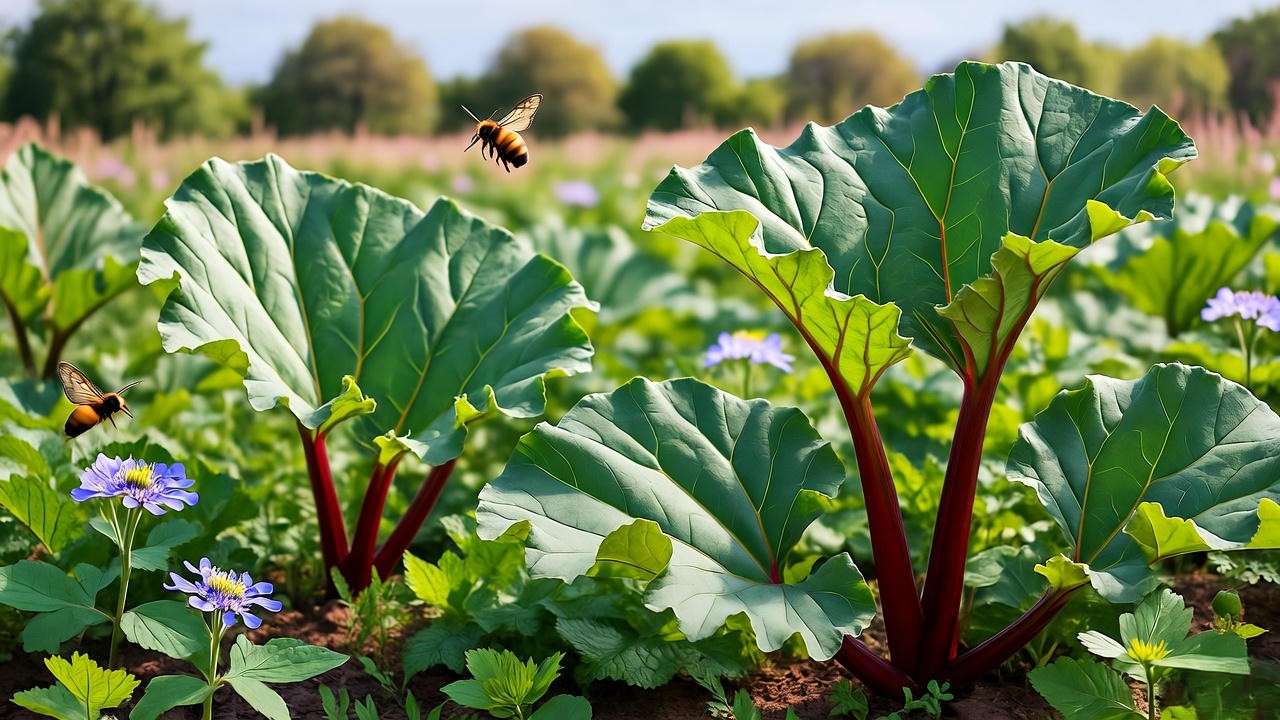
9. FAQs About Wild Rhubarb Plant Care ❓
Q1: How long does it take for wild rhubarb to mature?
A: Wild rhubarb typically takes 2–3 years to produce harvestable stalks. Avoid harvesting in the first year to allow the plant to establish a strong root system.
Q2: Can I grow wild rhubarb in containers?
A: Yes, but choose a large container (at least 24 inches deep and wide) to accommodate its extensive roots. Ensure excellent drainage and regular fertilization.
Q3: Why are my rhubarb stalks thin and weak?
A: Thin stalks may result from overcrowding, insufficient sunlight, or nutrient deficiency. Divide plants, ensure 6+ hours of sun, and fertilize with compost or a balanced fertilizer.
Q4: Is wild rhubarb safe for pets?
A: The stalks are safe in small amounts, but the leaves are toxic to pets and humans due to oxalic acid. Keep pets away from foliage and dispose of leaves properly.
Q5: How do I divide and transplant wild rhubarb?
A: Divide crowns in early spring or fall every 4–5 years. Dig up the plant, cut the crown into sections with at least one bud each, and replant in prepared soil.
These answers draw from horticultural research and hands-on experience to address common gardener concerns.
10. Conclusion: Why Grow Wild Rhubarb? 🌟
Wild rhubarb is more than just a garden plant—it’s a versatile, low-maintenance perennial that rewards you with nutritious stalks, vibrant beauty, and ecological benefits. Whether you’re savoring a homemade rhubarb pie or admiring its lush foliage, this plant brings joy to any garden. With the right care—proper planting, consistent maintenance, and timely harvesting—your wild rhubarb will thrive for years, offering a sustainable and delicious addition to your landscape.
Ready to start your wild rhubarb journey? Follow the tips in this guide, and you’ll be harvesting tangy stalks in no time! Share your rhubarb-growing experiences or favorite recipes in the comments below, and explore our other plant care guides for more gardening inspiration. 🌼












